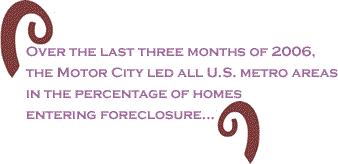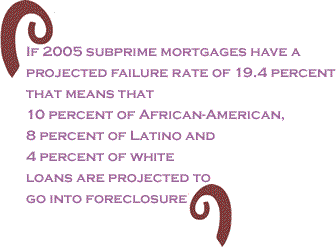
|
|||||||||||||||||||||
 |
|||||||||||||||||||||
 |
|
|
Economic opportunity, said Ben Bernanke, chairman of the US Federal Reserve “should be as widely distributed and as equal as possible". That was the first of three principles he spelled out for economic policy in a recent speech. Further, he said, “economic outcomes need not be equal but should be linked to the contributions each person makes to the economy” and “people should receive some insurance against the most adverse economic outcomes, especially those arising from events largely outside the person's control." If there are people in need of the third of Bernanke’s principle it is the people of Detroit. They haven’t been hit by a natural disaster. Rather, they have fallen in the path of an economic tsunami of devastating proportions. Right now they are being hit hard by the forces of globalization and technological change. The city of less than a million people, over 80 percent of who are African American, in a metropolitan area of over 4.5 million, has become something like the epicenter of the crisis of deindustrialization adversely affecting black communities around the country. Last week the city was delivered a new blow when DaimlerChrysler announced it will cut 13,000 jobs in North America. According to the company announcement, much of the effect would be in southeastern Michigan, where 5,300 people will lose their jobs over the next two years. For the state as a whole, the job loss will include 1,000 positions at the Warren truck plant, 250 jobs at a Detroit axle plant, nearly 200 more at the Mack Avenue Engine Plant I in Detroit, 100 at an engine factory in suburban Trenton, 65 more at a stamping plant in Sterling Heights and 100 at a stamping plant in Warren. In addition, about 1,600 of the 2,000 white-collar layoffs will come at the company’s Auburn Hills headquarters. According to the Associated Press, an additional 1,000 Michigan jobs will go, as Chrysler explores selling support businesses not involved in its core car-building, and 1,000 will be lost because of “productivity improvements.”
Industry observers are saying there will be additional job loss if, as some suspect, the German parent DaimlerChrysler spins off the Chrysler wing. This is only part of the bad news visited upon the city over recent months. In 1996, metro Detroit was cited as having the lowest home foreclosure rate of any of the large metro areas surveyed in the country. Over the last three months of 2006, the Motor City led all U.S. metro areas in the percentage of homes entering foreclosure, at more than four times the national average and 43 percent larger than the same period in 2005. Over the course of the first two months of this year, the Detroit- Wayne County home foreclosure total more than doubled reaching the nation’s highest for a metropolitan area - one new foreclosure filing for every 124 households Wayne County has moved past Greeley, Colorado to recording the highest rate of home foreclosures among major metro areas in the nation - seven times more than the national average. There were 6,653 new foreclosures there in January, more than twice the number reported in December. The rate went up in nearby Oakland and Macomb counties as well. The state of Michigan moved into second place among the 50 states for new foreclosures, behind only Nevada. CNNMoney.com noted that, “The three cities with the highest foreclosure rates were a wildly disparate bunch; the Motor City, where auto industry woes have taken a huge toll on homeowners, was followed by Ft. Lauderdale in the Sun Belt, and Denver, the first city of the Rockies.”
Since last fall, the number of homes nationwide in some stage of foreclosure continues to rise across the nation. More than 1.2 million foreclosure filings were reported nationwide during 2006, which is a rate of one foreclosure filing for every 92 households, according to RealtyTrac, Inc. The number of homes in the United States foreclosed by lenders rose 42 percent in 2006 from a year earlier – “a sign that many homeowners have became overextended in mortgage debt.” The principal cause of this escalation of foreclosures is the vast numbers of “subprime” mortgages taken out over the past decades or so. In 2005, the subprime mortgage market had grown to $665 billion, 23 percent of the entire mortgage market – up from $35 billion in 1994. Michigan's economy is essentially stagnant because of the woes of the auto industry, which has shed tens of thousands of jobs in the past few years, with more cuts to come, wrote David Oates in the Detroit News. “The climbing foreclosure rate in Michigan and the rest of the nation comes partly because many homeowners are grappling with higher monthly mortgage payments. When mortgage rates scraped bottom a few years ago, thousands of homeowners opted for adjustable-rate loans to buy homes at initially low rates. Others used the low intro-rate loans to refinance or to take out home equity loans." “Now rates on those loans are starting to climb.” As much as $1.5 trillion in adjustable-rate mortgages are due to have their rates reset this year, according to the Mortgage Bankers Association.
“Although white, non-Latino homeowners have three times as many high-cost mortgages, the impact of foreclosures will be felt far more in the African-American and Latino communities” wrote Glenn Haege in the Detroit News Jan. 2. “Fifty-two percent of the loans granted to African Americans and 40-percent of Latino loans are "high-cost loans" (a proxy term for subprime loans). The percentage for whites is only 19 percent. If 2005 subprime mortgages have a projected failure rate of 19.4 percent that means that 10 percent of African-American, 8 percent of Latino and 4 percent of white loans are projected to go into foreclosure.” The majority of subprime loans have been refinances, rather than new home mortgages, says Haege. “A major reason for this is families with after-tax incomes in the bottom 60 percent have only seen their incomes climb 5 to 15 percent during the past 20 years, while housing, childcare and health care costs have risen 53 to 75 percent.” Of course, for the people of Detroit and surrounding area this has been compounded by the steady loss of jobs. Now it turns out that while the market in subprime mortgage loans market has, in the words of one observer, “fallen into the sea.” the loans might just as well be called sub-subprime. “It is becoming clear, however, that subprime mortgages are not the only part of this market experiencing strain. Even paper that is in the midrange of credit quality — one step up from the bottom of the barrel — is encountering problems,” wrote Gretchen Morgenson in the New York Times on Feb. 18. That part of the market “used to consist of mortgages issued to professionals, like doctors, with unpredictable incomes.” Now it “is dominated by so-called affordability mortgages, adjustable-rate interest-only loans, 40-year loans and silent-second loans. You, dear risk-taking homeowner, know all about these loans that allowed people to buy a house that might have been beyond their means but looked attractive because they didn’t need to make payments on the principal in the early years.” At the moment 3.16 percent of these loans are delinquent by two months or more and the percentage is expected to rise, putting additional people at risk of losing their homes. This month the surge in home foreclosures began to receive attention in Congress. On Feb. 7, the Senate Banking Committee held a hearing at which committee chair Sen. Christopher Dodd (D.-Conn.) said the mortgage industry has to take greater responsibility and federal regulators may have to intervene – the latter a suggestion banking industry witnesses immediately rejected. "We are seeing increasing evidence that this important source of wealth for so many American families is under a grave threat from predatory, abusive and irresponsible lending practices undertaken by too many subprime lenders," said Dodd. "The industry has got to step up," Dodd said.
The Rev. Jesse Jackson, testifying at the hearing, said Congress must pass "strong laws to protect the vulnerable" by curbing abusive home-loan practices. "Lenders and brokers have financial incentives to place borrowers in more expensive loans," Jackson said. "It puts responsible lenders at a competitive disadvantage with the irresponsible lenders, allowing unscrupulous predatory lenders to control the market." Dodd and Jackson are correct. Something must be done to curb these lending practices. There must be new regulations and oversight. However, to my mind it still begs an essential question. What is to be done about the plight of the people facing homes foreclosures and evictions and will in even larger numbers in the months ahead? Surely they should be given some relief. If the foreclosures are not curbed, a lot of pain and anguish will spread across the land. Finding a solution is the job of those sworn to protect the general welfare. What is shocking and deplorable about this situation is how little media attention it gets. The picture it presents can usually be gleaned only from the business section of the daily press. And there, it is usually laid out from a particular angle. More often than not, the concern is expressed over the possible affect the foreclosure developments will have on the banks and lending companies that made the loans and on the general health of the economy. Little concern is expressed over the fate of the borrowers. This is, of course, consistent with the reigning ideology: the “market economy” carries risks and a rising tide lifts all boats. The reality is, only some boats are rising and the passengers on others are being left to sink or swim in unfathomable waters. If there is anything working people in our country are not being offered it’s any (in the Fed chair’s words) “insurance against the most adverse economic outcomes, especially those arising from events largely outside the person's control." BC Editorial Board member Carl Bloice is a writer in San Francisco, a member of the National Coordinating Committee of the Committees of Correspondence for Democracy and Socialism and formerly worked for a healthcare union. Click here to contact Mr. Bloice. |
|
| Home | |
| February
22, 2007 Issue 218 |
||||||||||||||
|
||||||||||||||
| Printer Friendly Version in resizeable plain text format | ||||||||||||||
 |
||||||||||||||
|
||||||||||||||
 |
||||||||||||||
 |
||||||||||||||
 |
||||||||||||||
| |
||||||||||||||
| |
||||||||||||||
































